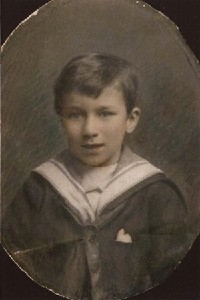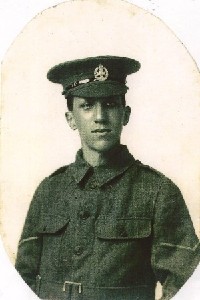
Rupert as a young boy

Rupert in uniform
Linda Gowans has submitted the following:-
Rupert was born in Whitburn, the eldest of five children of Thomas Edward Bryers, Solicitor, of Sunderland and his wife Augusta, née Hancock, a vicar’s daughter and children’s writer. In 1901 the family was at 2 Sidecliffe. In 1905 his father died in an accident at Aysgarth Falls, aged only 33.
In 1911 Rupert was with his uncle Edwin C. Dodd, aunt Annie (née Bryers) and their two children in Lewisham. Rupert attended Colfe’s School, in S E London from 1906 to 1912. There he became a close friend of Henry Williamson (later to become well known for his book Tarka the Otter, but the author of many other works), with whom he shared a deep interest in ornithology, and whose 1913 'Letts' School Boy’s Diary includes a bequest of his diaries and birds’ eggs to Rupert.
The adult Williamson, who from 1913 mentioned Rupert in his books, wrote in his journal for March 21st 1921:A strawmottled owl (short-eared) flapped in silence. "Ah" I thought, "I will come here later on and find his nest. Oh ecstasy, I have never found a marsh owl’s nest before. What will "Bony" at school and Rupert Bryers say. And then I remembered that I was twenty-five; and that dear tall old "Bony" was also grown up and that Rupert Bryers, the gentle eyed, fell in the second battle of Ypres somewhere up in the Death Salient.
Rupert left school at 16 and returned to Sunderland, assisting the Scoutmaster Mr Atlay when a troop was first started at St Gabriel’s in 1913. By that time his family home was 32 Mount Road. For a while he carried on the work when Mr Atlay left for war service. A railway enthusiast, good with timetables, he had passed the entrance exam and was due to join the NER at York when war broke out. He knew Morse code, presumably from his involvement in the Scouts, and was a fluent French speaker. He worked on the staff of the divisional superintendent, North Eastern Railway at Newcastle.
On May 15th 1915 at Sunderland, aged 19 years and 6 months, he joined The Rifle Brigade, giving his occupation as Clerk. He was promoted to Lance Corporal, and was due for leave, but the Somme campaign intervened, and he was killed on the first day of the Battle of Flers-Courcelette – the battle in which both Richard Mordey Liddle and J. E. Radcliffe Rosier also lost their lives, and in which Anthony Eden, the future Prime Minister, took part. It was the first tank battle in history.
Rupert’s mother Augusta died on September 4th 1930, aged 62. A notice in A History of St Gabriel’s Church Bishopwearmouth, by C. H. Walker (1938), page 34, records that: ‘She had been the leader of the Young Women’s Bible Class, and was a wise and sympathetic guide to the girls of the district. She was also the first woman to be elected to the Church Council.’ She served on the latter from 1921 to 1930, and is also recorded as President of a Girls’ Club established in the interests of social welfare.
Photos courtesy of Tim Bryers, Rupert’s nephew. Thanks for information to him, and to the Henry Williamson Society, some of whose members visited Rupert’s grave in April 2013.
Rupert Bede Bryers is remembered at Sunderland on S140.009, S140.010, S140.048 part 5, and S140.128 and at York on the North Eastern Railway Memorial

